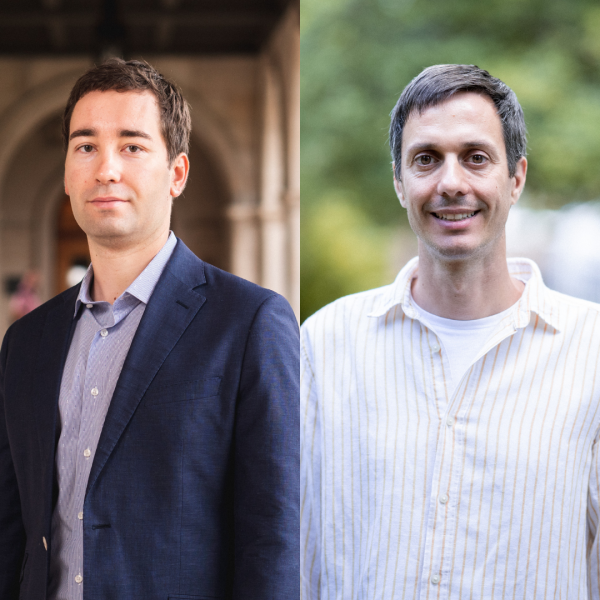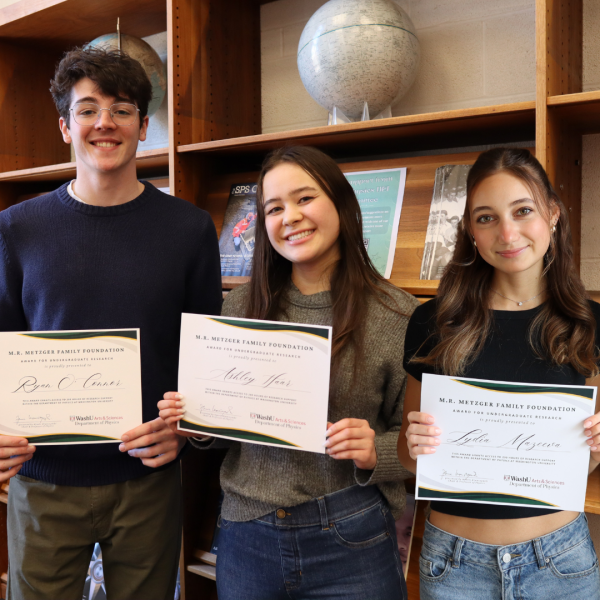What happens when biological and artificial intelligence meet?
Since its launch in 2022 as a multiyear project funded by the Incubator for Transdisciplinary Futures, Toward a Synergy Between Artificial Intelligence and Neuroscience has explored the intersections between the human brain and the novel AI networks that seek to emulate its functions.
On May 15, that work culminated in the NeuroAI Symposium, an all-day event that featured an international coterie of scholars and scientists who work on the cutting edge of AI and neuroscience research.
Ralf Wessel, a Washington University professor of physics and one of the faculty leads for the AI and Neuroscience project, summed up the symposium’s ambitious agenda as he welcomed attendees to a packed second-floor classroom in Crow Hall.
“The most exciting thing about today is the range of topics within NeuroAI,” Wessel said, “from a single neuron’s activity all the way up to creativity. To do this all in one day is pretty cool.”
Presenters included representatives from Harvard Medical School, Reality Labs at Meta, and MIT, as well as speakers visiting or Zooming in from institutions in Canada, Finland, and Switzerland. The speaker lineup featured a fascinating mix of researchers from academia and industry – or some, such as opening speaker Patrick Mineault, who have moved fluidly between both worlds.
A senior machine learning scientist at Mila, a Montreal-based artificial intelligence institute, Mineault discussed how the work of neuroscientists and AI developers could create a positive feedback loop to supercharge development in both fields.
“If we learn principles from our brains, we could eventually build better AI,” Mineault said. “And if we have better AI, that helps us to better understand the brain.”
As Mineault pointed out, neuroscience research is riddled with barriers: often requiring animal test subjects, large budgets, and extended timeframes to produce useful findings. But if advances in AI eventually help scientists to develop virtual brains for study, effectively removing those real-world barriers, neuroscience would become a wide-open field ripe for groundbreaking research.
But there is a vast gulf between that aspirational future and the current state of research in the field. As much as generative AI applications like ChatGPT, Midjourney, and others have wowed the public and sparked an ongoing industry gold rush, the actual leap toward human-level thought and problem-solving remains elusive.
Several NeuroAI Symposium presentations highlighted those gaps: Niru Maheswaranathan, a research scientist at Meta Reality Labs, highlighted AI’s ability to conduct sentiment classification on pieces of text – in essence, determining if a sentence expresses a positive or negative opinion. While the neural network in this particular study could repeatedly nail the basics of this task, there were still simple ways to short-circuit its analysis through the use of double negatives or sarcasm.
“In terms of more subtle descriptions we would use like irony and things like that, we haven’t gone that far,” Maheswaranathan said.
In his symposium-closing presentation, MIT’s Guangyu Robert Yang highlighted the missing ingredients needed to build what he termed “digital humans”: components like autonomy, emotion, and a coherent narrative of the world and the self. But Yang is an optimist, and sees AI’s evolution on a relentless upward trajectory.
“Can we build machines that bridge this gap?” Yang asked the audience. “I hope for you, the answer is ‘yes.’ The only question is, ‘when?’”
Wessel said that the presentations sparked discussions among both academics and students in attendance. He noted that Yang, in addition to his work at MIT, co-founded Altera, a company that develops AI agents that can play video games alongside human players while providing lifelike interactions within the game world.
“Robert’s transition from academia to starting his own business triggered much hallway discussion on the pros and cons of the various career paths at the intersection of AI and neuroscience,” Wessel said. “This fluid nature of career opportunities is much appreciated among students.”
Moving forward from its symposium, the Artificial Intelligence and Neuroscience group wants to develop into a training resource for the WashU students who will explore the overlaps between digital and human brains.
“The question of how best to train students for the NeuroAI revolution came up in multiple conversations at the symposium,” Wessel said. “The need for training the next generation of NeuroAI scientists motivates us to coordinate with federal agencies about attracting relevant institutional training grants to WashU.”





